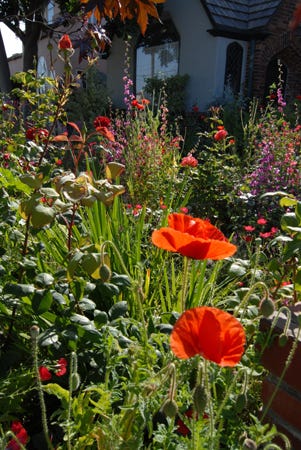The Red Poppy
The small, fragile, brilliantly red poppy is probably the world's most popular wildflower.

The Red Poppy is so popular and widespread, in fact, that there is some confusion about it. No, even though the seed looks about the same, it is not the species used for making poppy seed rolls in baking. And it is also not the famous species used in the production of opium and heroin. The Opium Poppy, Papaver somniferum, a larger annual species, is the one that produces the seeds for baking and also the narcotic sap for illegal drugs.
Shop for Red Poppy seeds, Mixed Red Poppy Seeds, and our entire poppy wildflower seed assortment
The Red Poppy is also not the one that produces the big flashy flowers every spring in perennial gardens. That's the Oriental Poppy, P. orientale, and its much larger blooms are basically orange, but have been hybridized into many other colors, including red. And it's not the species known as Iceland Poppy, P. nudicaule, another one that's very popular in gardens in shades of orange, white and pink.
The Red Poppy is the small-size annual species (only about 12" to 14" tall with blooms from 2" to 3" wide) that is sometimes called "Shirley Poppy", "Flanders Poppy," "American Legion Poppy", and in England, "Corn Poppy."
The name "Shirley" doesn't define a hybrid or "cultivar." It's after a British vicar in the village of Shirley, England who gathered wild-occurring specimens of Papaver rhoeas for study and created a natural group that includes not only the
basic red, but also pinks, whites, and double forms.

The Red Poppy is native to most all of Eurasia and North Africa, but today is best known for its range in Central Europe, where it became permanently linked with war. During World War I, the fields of Flanders (western Belgium) and other areas, experienced four full years of unrelenting war and destruction. An astounding number of approximately 10 million soldiers were killed, and another 20 million wounded. Battle losses were greater than any war before or since.
The once bucolic meadows of Flanders had long been graced by the brilliant red wildflowers each spring and summer, but during the Great War, the poppies disappeared. Since they are annuals, and grow quickly from seed each spring, the constant trampling and bombing of the battlefields simply stopped the famous bloom for four full seasons. When the war was over, and the poppies were able to bloom again, the display was spectacular. Actual seed counts were taken, and over 2,500 poppy seeds per square foot were found.
Obviously, the post-war, blood red bloom from the fields of battle had a huge impact on all who saw or heard about it. But surely the most lasting memorial is the famous poem by Canadian battle surgeon/poet, John McCrae. Like The Star Spangled Banner, written in Baltimore Harbor during the bombardment, this poem was written on the spot, as he gazed at fresh graves of his friends and comrades, and poppies "blowing" in the wind.

In Flanders Fields
by John McCrae
Written in Flanders on May 3, 1915In Flanders fields the poppies blow
Between the crosses, row on row,
That mark our place; and in the sky
The larks, still bravely singing, fly
Scarce heard amid the guns below.We are the Dead. Short days ago
We lived, felt dawn, saw sunset glow,
Loved, and were loved, and now we lie
In Flanders fields.Take up our quarrel with the foe:
To you from failing hands we throw
The torch; be yours to hold it high.
If ye break faith with us who die
We shall not sleep, though poppies grow
In Flanders fields.
Red Poppy is the symbol of the American Legion, handed out for Memorial Day, and worn in lapels for the same symbolism in Great Britain on Remembrance Day. It's obvious why two of the common names of the wildflower today are "Flanders Poppy", and in the United States, "American Legion Poppy."
>Red Poppy is a wildflower gardener's favorite since it grows so easily and successfully in meadows. In the photo above, it is planted with blue cornflowers. Both are treasured wildflowers for meadows in the UK and the US.
It's also wonderful to know that this treasured wildflower is so easy to grow. Almost any sunny spot is fine, and though it prefers neutral to alkaline soils, it it is quite adaptable. The only condition it won't tolerate is very heavy clay. Like all poppies, this one develops a tap root, and if the soil is very heavy, it is almost impossible for it to drive down its tap root in time for good bloom. So plant your Red Poppies in loose soil, and enjoy them as people do worldwide.

Cutting poppies. You may read that Red Poppies "do not cut." But don't you believe it. Almost everyone who grows them is anxious to cut a few and bring their stunning beauty inside and create an arrangement to enjoy.
It's true that the flowers are very fleeting, lasting in a vase sometimes only for hours. They don't wilt, but the delicate petals begin to fall quickly. To avoid this, there is something you can do. As you cut the flowers, take only the freshest. Then use a large match or cigarette lighter, holding the cut end of the stem over the flame, and let it sear the end of the stem until it's almost black. This seals the milky juices into the stem, and usually at least doubles the life of the flower in water. Even with searing, your arrangement won't last long, and you may want to put a tray or large plate under the vase to receive the red petals as they fall, making cleanup easier. But don't hesitate; if you want poppies on the table, cut them and enjoy. Everybody will love them.